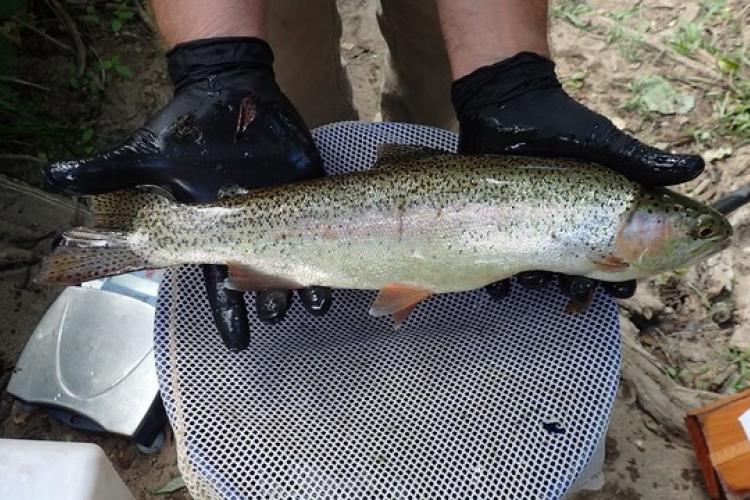Improvements in fish passage and assurances of water in California’s Calaveras River will help promote recovery of threatened steelhead. These changes will be implemented under the first plan of its kind in the Central Valley of California.
The Calaveras River Habitat Conservation Plan finalized this week includes commitments by the Stockton East Water District to improve conditions in the Calaveras River for steelhead. In turn, the Water District gets assurances that it can continue distributing water to irrigators and others without violating the Endangered Species Act.
It is the first Habitat Conservation Plan that NOAA Fisheries has completed in the Central Valley. It reflects a partnership with the Water District to help recover a core population of threatened steelhead while also maintaining water supplies for agricultural and municipal use.
The Plan includes a commitment from the Water District to conserve threatened steelhead in ways that will benefit the population in the long-term. In turn, the District can carry out its usual operations and serve customers even if it might have limited incidental impacts on fish. The Plan also includes a forum for public discussion and input into river management.
“There is something here for everyone,” said Monica Gutierrez, fisheries biologist, who has led the development of the Plan for NOAA Fisheries’ West Coast Region in Sacramento. “The Water District gets security and predictability in its water supply while we are also improving conditions for fish in key habitat at a critical time.”
“The Water District is proud that the Calaveras River supports a healthy steelhead population,” said General Manager Scot Moody. “The District is thrilled that we can support the fish, while at the same time protecting the needs of our agricultural and municipal water users,” he said. “We’re making a commitment, and we get some certainty in return.”
The Calaveras River flows out of the Sierra Nevada Range, through Stockton and into the San Joaquin River. It has long supported rainbow trout and their ocean-going form, steelhead, which are protected as a threatened species under the Endangered Species Act. The river also provides water for agriculture and municipal uses in Calaveras and San Joaquin counties.
The Water District has funded extensive research and monitoring of the fish populations in the Calaveras River. This information has helped make adaptive management adjustments that will help provide conditions that fish need. The Water District has also provided some interim actions such as temporary fish ladders and a fish screen. These measures will improve fish passage and avoid drawing fish into irrigation works.
Longer term conservation actions under the Calaveras River Habitat Conservation Plan include:
— Maintaining minimum flows in the upper Calaveras River to support steelhead spawning and chinook salmon that may sometimes enter the river, while coordinating irrigation and flood storage releases to benefit fish when possible.
— Improving passage opportunities into and out of the 18-mile spawning and rearing reach of the river between Bellota Weir and New Hogan Dam.
— Installing barriers and fish screens on private diversions to keep fish from being drawn into irrigation channels and encouraging irrigators to adopt water conservation methods.
— Protecting water quality and fish from impacts of work in river channels and irrigation systems.
“This plan is a testament to the dedication of Stockton East Water District and our NOAA Fisheries staff who put immense energy and creativity into developing an approach that provides the infrastructure, science, and species protections to meet everyone’s needs,” said Cathy Marcinkevage, Assistant Regional Administrator for the California Central Valley Office in NOAA Fisheries’ West Coast Region.
Year-round flows in the Calaveras River have supported a small population of steelhead, keeping both steelhead and salmon in good condition. Depending on the variability of annual rainfall, a range of 319 to 2,769 juvenile steelhead have been captured annually in the river. The range for the downstream migrant population has been between 884 to 13,670 individuals. These numbers far exceed numbers in other nearby tributaries. For example, in the Stanislaus River, annual numbers captured are about 50 and estimates of downstream migrants are 500–700 fish each year.
“This is an exciting step in conserving steelhead in a lasting way that works for everyone,” said Erin Strange, NOAA Fisheries Supervisory Fishery Biologist for the San Joaquin River Branch. “We’re committed to partnering with the Water District and other stakeholders in the Calaveras River to support a healthy watershed and reliable water supply.”
The recovery plan for Central Valley steelhead identifies the Calaveras River as a core population in the Southern Sierra and San Joaquin watershed that is essential to recovery of the species. Low flows and limited habitat are some of the main threats to these fish, and the Habitat Conservation Plan addresses each.
“We all will be thrilled to see this Plan succeed, because that means healthy fish, it means successful agriculture, and it means water for the Stockton urban area,” Moody said. “We’ve worked together to get here.”

